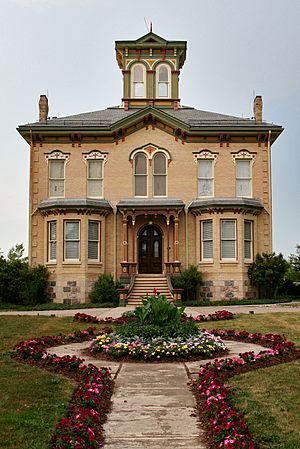Castle Kilbride facts for kids
Quick facts for kids Castle Kilbride |
|
|---|---|

Castle Kilbride, Baden, ON
|
|
| Location | Baden, Regional Municipality of Waterloo, Ontario, Canada |
| Elevation | 354 metres (1,161 ft) |
| Built | 1877 |
| Original use | Residence of James Livingston |
| Website | Historic Castle Kilbride |
| Designated | March 1994 |
Castle Kilbride is a beautiful old house in Baden, Ontario, Canada. It used to be the home of James Livingston. He was a very successful businessman and a member of the Canadian Parliament. This amazing building was named a National Historic Site of Canada in March 1994. This means it's a really important place in Canadian history!
The house was built in 1877. It was named after Livingston's birthplace in Scotland. Inside, Castle Kilbride has amazing decorative murals. These paintings are in the style of the Italian Renaissance. They use a special art trick called trompe-l'œil. This makes the flat paintings look like they are three-dimensional! The building itself is also a great example of an Italianate villa. When it was built, it showed how important James Livingston was. People called him the 'Flax and Oil King of Canada'.
Contents
History of Castle Kilbride
The first owner of Castle Kilbride was James Livingston. He was born in East Kilbride, Scotland, on November 28, 1838. James moved to Canada from Scotland when he was about 16 years old. He arrived with very little money. He went to Baden and started working with his older brother, John. They earned simple wages to support themselves. After a while, the brothers saved enough money to start a small flax farm.
In 1861, James Livingston married Louise Liersch. To make processing flax easier, the brothers built a flax mill in 1863 and another in 1864. Over about ten years, James and John's mill processed a lot of flax. James chose a very smart crop. At that time, there was a high demand for other fabrics besides cotton. This was because the American Civil War had greatly damaged the cotton industry. Flax was a very profitable crop. It could be used to make hemp for linen cloth. It also produced linseed oil.
The Flax and Oil Business
The second mill built in Baden in 1874 made linseed oil. Linseed oil was used to make oil paint. Because of this, the demand for linseed oil grew. This led the Livingston brothers to create the 'J&J Livingston Linseed Oil Company'. By 1881, the Livingston brothers owned over 3,000 acres used for flax farming. They had a very successful business.
James Livingston built Castle Kilbride to celebrate his success. The house was finished in 1877. This was also the year James Livingston was elected Reeve of the Township of Wilmot. A Reeve is like a mayor for a township.
James's older brother, John, passed away in 1896. This made James the head of the entire business. Later, the Baden Linseed oil mill was managed by his son, John Peter.
After James Livingston retired, he held a picnic every year. All the company employees and their families were invited. After James Livingston passed away, his son John Peter, his wife Laura, and their daughter Laura Louise moved into Castle Kilbride. The Livingston oil company started to decline later on. This was because new types of paint, like latex paint, became popular.
Castle Kilbride was sold to the Township of Wilmot in 1993.
Building and Features
Building Castle Kilbride took about one year. It was finished in 1878. A local builder named David Gingerich constructed it. The house has three main floors. It has over 10,000 square feet of living space. The only big addition was in 1920. That's when a summer kitchen was added.
Castle Kilbride has some fun and unique features. For example, the front lawn is shaped like a heart. This was a special tribute to Livingston’s wife, Louise.
In 1988, the Livingston family sold the home's furniture and items at an auction. The house then sat empty for several years. In 1993, the Township of Wilmot bought it. They started working to restore it. To help save the building, and because of its amazing interior decorations, Castle Kilbride was declared a National Historic Site in 1995.
Castle Kilbride Today
Today, Castle Kilbride is used as an event venue and a museum. It shows original furniture and household items. It also displays more modern artifacts. In 2016, the area next to the castle became home to the Prime Ministers Path. This path has bronze statues of Canadian prime ministers. It helps visitors learn about Canada's history since Confederation. Castle Kilbride also offers guided ghost walks, which can be a fun and spooky way to explore the old house!
See also
- List of historic places in Regional Municipality of Waterloo
- List of oldest buildings and structures in the Regional Municipality of Waterloo

